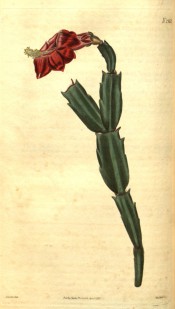Schlumbergera truncata (Haw.) Moran
Frost tender, epiphytic cactus with oblong, glossy stem segments with tooth-like marginal notches and deep pink, red, orange or white flowers, to 7cm long, in autumn. To 35cm. [RHSE, Hortus].
Horticultural & Botanical History
Cereus truncatus Sw. = Schlumbergera truncata var. altensteinii. ‘This plant is very much branched, the terminal joint only of each branch bears a solitary rose-coloured shewy scentless flower, the inner petals of which are very much reflexed, and the opening oblique, the stamens and style ascendent. As the branches are very numerous and the terminal joints in a thrifty plant generally productive of a flower, it makes altogether a handsome appearance.’ It probably first flowered in Europe in the Prince de Salm Dyck’s collection in 1720. [BM t.2562/1825].
‘Introduced to England in 1821. It possesses great beauty. Like most of this family the branches are of curious form and growth; they are quite flat, divided in joints of about three inches in length. the flowers grow out of the ends, usually in the autumn.’ [LBC no.1207/1827].
‘The dwarf habitude of [Epiphyllum truncatum], its gracefully half-drooping branches, the singular form, interesting disposition, and admirable tints of its flowers, with their development in the depth of winter, when most succulents are enjoying complete repose, render it an invaluable acquisition to any garden. And if the lovely hues of its blossoms are admitted as one of its principal attractions, the variety here first figured [violaceum] must stand pre-eminent in that particular.’ Evidently a large number of colour forms were available by 1841. [MB p.79/1841].
‘The fine blossom of this newly imported species made its first appearance, we believe, last summer in several of our gardens together.’ Cultivated in Europe since 1818. [BR f.696/1823].
History at Camden Park
Listed as Cereus truncatus in the 1843 and 1845 catalogues and as Epiphyllum truncatum in the 1850 and 1857 editions [T.417/1850]. Received per ‘Sovereign’ February 1831 as Cactus truncatus. [MP A2948] and ticked in a copy of the Hort. Reg., December 1831, although this originally belonged to James Bowman and only later to William Macarthur, it may indicate that this plant was grown earlier than 1843 by some members of the extended Macarthur family.
Notes
Published Mar 02, 2010 - 05:00 PM | Last updated Jul 15, 2010 - 05:32 PM
| Family | Cactaceae |
|---|---|
| Category | |
| Region of origin | Brazil |
| Synonyms |
|
| Common Name | Christmas cactus, Crab cactus |
| Name in the Camden Park Record |
Cereus truncatus Epiphyllum truncatum |
| Confidence level | high |


